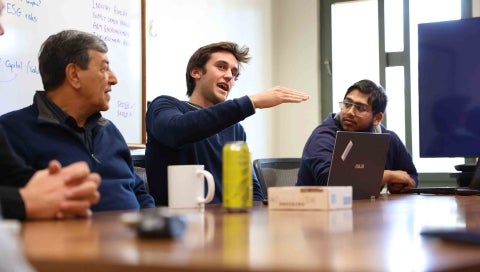Cal Poly Business Students Win the Americas' CFA Institute Research Challenge
Contact: Pat Pemberton
(805) 235-0555; ppembert@calpoly.edu
“Luna Capital Management” will compete for $20,000 prize at the May 3 global finals — the first time for a Cal Poly team
SAN LUIS OBISPO, California — An in-depth analysts' report developed by a team of Cal Poly finance students has won first place in CFA Institute Research ChallengeAmericas’ competition, allowing the team to advance to the global finals (the first time for a Cal Poly team), set for May 3 in Washington, D.C.
The competition, which began with over 1,000 university teams, is now down to six. The other finalists are: California State University, Fullerton; Universitas Indonesia; University of Sydney (Australia); Polytechnic University of Milan (Italy); and University of Neuchâtel (Switzerland).

Photo by Pat Pemberton | Cal Poly
“Our students have been working hard on this project since October of 2022,” said faculty advisor Cyrus Ramezani. “They have survived five rounds of presentation, emerging as winners at each round, and in the process beating nearly 30 other teams.”
The Cal Poly team includes four financial management seniors: Benjamin Roe of San Diego; Brenden Rogers of Redmond, Washington; Samantha Gottlieb of Lake Forest, California; Athénaïs Mortier of Fountainbleau, France; and accounting senior Jivitesh Kamboj of San Francisco.
The multi-stage competition started with over 6,400 students from 90 countries. While performing an in-depth analysis of a single company, students are tested on their analytical skills, valuation modeling, report writing and presentation skills. And, befitting Cal Poly’s Learn by Doing ethos, the competition entails learning that mirrors real world work.
“This is an analyst initiation report,” said Ramezani, who is also the Finance chair in the Orfalea College of Business. “The most detailed report issued on a firm by Wall Street analysts.”
Specifically, the Luna team (unofficially named after Mortier’s dog) prepared a 10-page investment analysis of Advanced Micro Devices Inc. (AMD), which competes with Intel in the semiconductor industry, designing chips for computing applications. According to the team’s initial report, AMD “possesses a weak economic moat despite recent innovations.”
While the team initially recommended a one-year target price of $85.92, “providing an expected return of 3.26% from the current price,” they must update their projections throughout the competition.
“Our team has learned how quickly information becomes stale, and adjusting our unbiased analysis has been a requirement throughout the competition as new data and news is released constantly,” Rogers said. “Q&A from the judges is our main challenge in these most recent rounds since they get an extra five minutes to dive deeper into our analysis and push us to defend our work.”
As the team prepared to enter the first round back in February, Mortier noted how keeping current added to the pressure.
“I keep getting scared that it’s going to change drastically, and everything we did for three weeks will need to be redone in a day,” she said.
When it was completed — after input from Ramezani and various alumni — Ramezani was particularly impressed with the report’s breadth and depth of analysis, “which competes with the very best professional reports on Wall Street.”

Photo courtesy of Cyrus Ramezani
Since the team began, Rogers said, Ramezani has told them they could go further than any other Cal Poly team has gone.
“After every long night preparing for this project, he always signed off with, ‘We’re going to the global finals’ and really instilled that confidence in us from the start,” Rogers said. “We are excited to get to represent Cal Poly in something no other students have been able to do and are more determined than ever to win it all.”
Prior Cal Poly teams have performed well, but none ever made it to the Americas’ regional finals. This one will now compete for the global victory — and a chance to win $20,000 — while gaining valuable career-making experience.
“It has been a chance to apply a lot of the concepts I’ve learned in class — to actually get my hands dirty,” Roe said. “Getting all the research and synthesizing has been a big challenge and also a great learning opportunity.”


